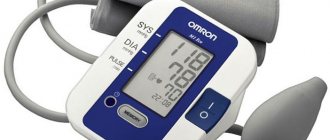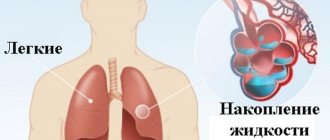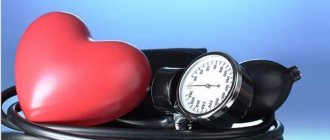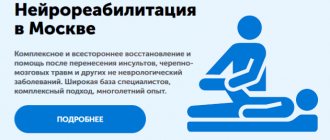Doctors Cost
Price list Doctors clinic
Treatment of dizziness in elderly patients is a complex task, which can be accomplished by a team of experienced doctors at a multidisciplinary clinic equipped with modern equipment. This disease is a consequence of various changes in the body that occur when organs and systems are damaged. Therefore, the approach to the disease must be comprehensive.
For reference:
An elderly person in Russia is considered to be a man aged 61–75 years old and a woman aged 56–75 years old.
Vertigo syndrome
Dizziness, or vertigo (from the Latin “vertigo”), is a condition in which a person in a stable position notices the illusion of movement of objects around him. In young people, vertigo may be the only symptom; in older people, it is usually accompanied by other symptoms: hearing loss, ringing in the ears, nausea, vomiting, and weakness in the legs. The severity of vertigo varies significantly - from insignificant to catastrophic. Severe dizziness in an elderly person, if left untreated, can lead to complete disorientation, incoordination, falls and injuries, and panic disorders.
Development mechanism
Several systems help a person navigate space and stay in balance:
- vestibulocochlear organ, visual and proprioceptive systems;
- Nerves connecting peripheral analyzers with brain structures;
- Central nervous system (CNS or brain and spinal cord).
If any of these systems fail, vertigo develops.
Systemic dizziness in the elderly. Causes and treatment
The condition is associated with damage to one or more systems, which is why it got its name. In people over 60 years of age, several systems are often affected simultaneously. The clinical picture and the recommended treatment regimen depend on the level of impairment.
There are peripheral and central vertigo.
Table 1. Some diseases accompanied by peripheral vertigo
| Diagnosis | Symptoms |
| Meniere's disease | Attacks are accompanied by hearing loss, nausea, tinnitus |
| Benign paroxysmal positional vertigo (BPPV) | Vertigo occurs when turning or tilting the head and lasts less than a minute. |
| Vestibular neuronitis | Severe rotational vertigo with loss of balance, vomiting, nausea. Often a complication of ARVI. |
| Perilymphatic fistula | Develops after injury, chronic otitis. An attack is provoked by changes in pressure and loud sounds. |
| Labyrinth infarction | Combined with tinnitus or one-sided deafness. |
Vestibular disorders are among the most common in clinical practice. According to a recent study conducted in the United States, clinically obvious or hidden vestibular disorders are observed in 35% of Americans over 40 years of age [1]. The most characteristic manifestation of vestibular dysfunction is vestibular vertigo (VV) - the illusion of movement or rotation of surrounding objects or the patient himself in space. Vestibular, or systemic, dizziness, although inferior in frequency to non-systemic, is nevertheless quite common: its prevalence among adults reaches 5% [2].
Vestibular vertigo can be divided into acute and chronic. Acute VH is usually combined with more or less pronounced autonomic disorders in the form of nausea, vomiting, increased or decreased blood pressure, sweating, pallor, etc. In addition, acute dizziness is accompanied by instability and nystagmus. The duration of acute dizziness ranges from a few seconds to several days, but in practice it rarely exceeds 6–12 hours.
Chronic VH is manifested to a greater extent by instability, while the illusion of movement of surrounding objects mainly occurs briefly in response to turning the head or eyes.
Acute VH is caused by sudden damage to the vestibular analyzer at any level. Damage to the vestibular analyzer at the peripheral level (labyrinth of the inner ear or vestibular nerve) is most often caused by benign paroxysmal positional vertigo (BPPV), Meniere's disease and vestibular neuronitis. Damage to the vestibular analyzer at the central level (vestibular nuclei of the brain stem and numerous connections of the vestibular nuclei with other parts of the vestibular analyzer) in most cases is a consequence of migraine, as well as stroke or transient ischemic attack in the vertebrobasilar system.
Chronic VH can be a continuation of acute (in such cases it is caused by insufficient vestibular compensation) or arises primarily due to the gradual development of a pathological process (for example, due to neuroma of the vestibular-cochlear nerve) or bilateral symmetrical damage to the vestibular analyzers (as in bilateral vestibulopathy caused by the action of ototoxic substances ).
The principles of drug and non-drug treatment of acute and chronic dizziness differ significantly.
Pharmacotherapy of acute dizziness
Regardless of the cause of acute dizziness, representatives of two main groups remain the drugs of choice: vestibular suppressants and antiemetics.
Vestibular suppressants include antihistamines, anticholinergics, and benzodiazepines. The main vestibular suppressants are listed in table. 1.
Antihistamines
For vestibular vertigo, only those H1 blockers that penetrate the blood-brain barrier are effective. These drugs include dimenhydrinate (Dramina 50–100 mg 2–3 times a day), promethazine (Pipolfen 25 mg 2–3 times a day orally or intramuscularly), diphenhydramine (Diphenhydramine 25–50 mg orally 3–4 times a day). day or 10–50 mg IM) and meclozine (Bonin 25–100 mg/day in the form of chewable tablets). All of these drugs also have anticholinergic properties and cause corresponding side effects [3].
Anticholinergics
These drugs inhibit the activity of the central vestibular structures. Scopolamine or platyphylline are used. Side effects of these drugs are mainly due to the blockade of M-cholinergic receptors and include dry mouth, drowsiness and accommodation disorders. In addition, amnesia and hallucinations are possible. Scopolamine should be prescribed with great caution to the elderly due to the risk of developing psychosis or acute urinary retention.
It has now been proven that anticholinergic drugs do not reduce CH, but can only prevent its development, for example, in Meniere’s disease [4]. Because of their ability to slow down vestibular compensation or cause compensation to fail once it has already occurred, anticholinergics are increasingly used less frequently in peripheral vestibular disorders.
Benzodiazepines
The inhibitory transmitter of the vestibular system is gamma-aminobutyric acid, and benzodiazepines enhance the inhibitory effects of gamma-aminobutyric acid, which explains the effect of these drugs in VH. Even in small doses, benzodiazepines significantly reduce dizziness and associated nausea and vomiting. The risk of drug dependence, side effects (drowsiness, increased risk of falls, memory loss), as well as slower vestibular compensation limit their use in vestibular disorders. Lorazepam (Lorafen) is used, which in low doses (for example, 0.5 mg 2 times a day) rarely causes drug dependence and can be used sublingually (at a dose of 1 mg) for an acute attack of dizziness. Diazepam (Relanium) at a dose of 2 mg 2 times a day can also effectively reduce GV. Clonazepam (Antelepsin, Rivotril) has been less studied as a vestibular suppressant, but appears to be as effective as lorazepam and diazepam. It is usually prescribed at a dose of 0.5 mg 2 times a day. Long-acting benzodiazepines, such as phenazepam, are not effective for vestibular vertigo [5].
Vestibular suppressants slow down vestibular compensation, so their duration of use is usually limited to 2–3 days [6].
Antiemetics are often used in the same circumstances as vestibular suppressants. Moreover, most vestibular suppressants are also antiemetics. Among the most common antiemetics are phenothiazines, in particular prochlorperazine (Meterazine 5–10 mg 3–4 times daily) and promethazine (Pipolfen 12.5–25 mg 3 times daily orally or IM). Metoclopramide (Cerucal 10 mg IM) and domperidone (Motilium 10–20 mg 3–4 times a day orally) are peripheral D2 receptor blockers that normalize gastrointestinal motility and thereby also have an antiemetic effect [7]. Ondansetron (Zofran 4–8 mg orally) is a serotonin 5-HT3 receptor blocker that also reduces vomiting in vestibular disorders.
Antiemetics, like vestibular suppressants, can slow down vestibular compensation, so the duration of their use for vestibular disorders is limited to 2-3 days. There is evidence that ondansetron has no effect on central vestibular compensation [8]. Drugs with predominantly antiemetic activity are presented in table. 2.
Pharmacotherapy of chronic dizziness
Vestibular suppressants and antiemetics are ineffective in chronic VH. Moreover, since many cases of chronic dizziness are caused by insufficient vestibular compensation, drugs that depress the vestibular system may aggravate the patient's condition and delay recovery.
The basis for the treatment of chronic vestibular dysfunction is non-drug methods, primarily vestibular rehabilitation. The goal of vestibular rehabilitation is to accelerate vestibular compensation and create conditions for rapid adaptation to damage to the vestibular system. Vestibular gymnastics is based on exercises in which movements of the eyes, head and torso lead to sensory mismatch [5, 9]. These exercises stimulate central vestibular compensation. Clinical studies have shown that improvements in vestibular function and stability as a result of vestibular rehabilitation are observed in 50–80% of patients. Moreover, for a third, compensation is complete [10–12].
The possibilities of drug stimulation of vestibular compensation are currently limited. However, studies of various drugs supposedly stimulating vestibular compensation are ongoing. One such drug is betahistine dihydrochloride. By blocking H3 receptors in the central nervous system, it increases the release of neurotransmitters from the nerve endings of the presynaptic membrane, exerting an inhibitory effect on the vestibular nuclei of the brain stem. Experimental studies have shown that Betaserc accelerates vestibular compensation [13, 14]. Betahistine dihydrochloride is used in a dose of 24–48 mg daily for one or several months.
There is evidence of acceleration of vestibular compensation in diseases of the peripheral part of the vestibular analyzer under the influence of Ginkgo biloba extract [15, 16]. The drug is prescribed at a dose of 120 mg/day orally for one or several months.
Another drug believed to improve the speed and completeness of vestibular compensation is piracetam. This drug changes the speed of spread of excitation in the brain, improves metabolic processes in nerve cells, normalizes connections between the cerebral hemispheres and synaptic conduction in neocortical structures. It is believed that piracetam affects the vestibular and oculomotor nuclei of the brainstem, accelerating vestibular compensation [17]. Piracetam is recommended primarily for dizziness caused by damage to the central vestibular structures. Piracetam is prescribed orally at a dose of 2400–4800 mg/day; Duration of treatment – from one to several months.
Pharmacotherapy of the most common vestibular diseases
Benign paroxysmal positional vertigo
The basis of treatment for BPPV is not drugs, but special exercises and therapeutic maneuvers that have been actively developed over the past 20 years [18–21].
Drug treatment is used only in the most acute period, when it is necessary to reduce the severity of episodes of positional vertigo, and as a premedication during positional maneuvers. In these cases, vestibular suppressants and antiemetics are used. In addition, there are limited data indicating the ability of betahistine dihydrochloride to increase the effectiveness of therapeutic positional maneuvers for BPPV [22] and reduce the duration of the period of instability after a successful positional maneuver [23].
Meniere's disease
To date, Meniere's disease remains an incurable disease. The goal of treatment is to reduce the frequency and severity of dizziness attacks [24–26]. For this purpose, diuretics are prescribed (acetazolamide or hydrochlorothiazide in combination with triamterene). However, to date, no convincing data have been obtained indicating the effectiveness of diuretics in Meniere’s disease [27].
Another drug that can reduce the frequency and severity of dizziness attacks in Meniere's disease is betahistine dihydrochloride. It is usually prescribed at a dose of 48 mg per day and taken long-term – for several months and sometimes years [14]. Recently, data have appeared on the effectiveness and safety of the use of high doses of betahistine in Meniere's disease [28].
Vestibular neuronitis
Drug treatment of vestibular neuronitis mainly consists of the use of symptomatic drugs: vestibular suppressants and antiemetics. Recently, evidence has emerged indicating the effectiveness of corticosteroids in vestibular neuronitis, but these data have not been confirmed by a meta-analysis [29].
Migraine-associated dizziness
The treatment of migraine-associated dizziness generally uses the same approaches as the treatment of regular migraine. However, due to the current lack of consensus regarding the diagnostic criteria for migraine-associated dizziness and the very fact of the existence of this pathology, there have been almost no controlled studies of the effectiveness of certain therapeutic approaches. To relieve an attack of migraine-associated dizziness, as with any other acute VH, vestibular suppressants and antiemetics are used. Preventive therapy is indicated for frequent (2 or more per month) and severe vestibular migraine attacks [30, 31].
The drugs of choice are beta-blockers (propranolol or metoprolol), tricyclic antidepressants (nortriptyline or amitriptyline) and calcium antagonists (verapamil). In addition, valproate (600–1200 mg/day) and lamotrigine (50–100 mg/day) are used. The starting daily dose of verapamil is 120–240 mg/day; the maximum daily dose should not exceed 480 mg. The starting dose of nortriptyline is 10 mg/day; if ineffective, the dose is increased to 10–25 mg/day, while the maximum daily dose should not exceed 100 mg. The starting dose of propranolol is 40 mg/day; if this dose is ineffective and the drug is well tolerated, the daily dose is gradually (weekly) increased by 20 mg, but so that it does not exceed 240–320 mg. There is also evidence of the effectiveness of topiramate as a means of preventing migraine-associated dizziness [32].
Thus, the possibilities of drug therapy for vestibular vertigo are quite large. There are a sufficient number of drugs for both symptomatic treatment of dizziness and pathogenetic therapy. Correctly selected and timely prescribed medications can significantly improve the quality of life of most patients with various diseases of the vestibular system.
Central vertigo in the elderly: causes, treatment
Associated with brain dysfunction.
Vestibular migraine.
It is characterized by attacks of dizziness with migraine-type headaches lasting no more than a day.
Impaired blood supply to the central nervous system.
Cerebral ischemia is often caused by embolic or atherosclerotic vascular lesions. This is dangerous for the development of a stroke.
Transient ischemic attack (TIA).
Associated with short-term (1 day) blockage or spasm of a blood vessel in the brain by a thrombus or embolus. With spontaneous restoration of the lumen, all symptoms disappear. Vertigo may be accompanied by nausea, numbness of one half of the face or body, weakness in the legs, and speech disorders.
Archer syndrome
caused by compression of the vertebral artery at the C1-2 level. When turning the head to the left or right, severe dizziness occurs.
Infarction or hemorrhage in the cerebellum.
Typical for elderly patients with high atherosclerotic risk, suffering from diabetes mellitus and hypertension. The disease begins acutely with dizziness, unsteady gait, and falling towards the affected side.
Multiple sclerosis.
Occurs when foci of demyelonization occur in the cerebellum. It is characterized by persistent vertigo that lasts for several weeks or longer.
The best drugs for dizziness with disorders of the vestibular apparatus
Violation of the vestibular apparatus also requires taking pills for nausea and dizziness. Their main task is to influence special histamine receptors that are located in the vessels of the inner ear. It can be taken once in case of long trips in transport, or as a course for maximum therapeutic effect. The top rating of 2021 presented 2 drugs in this category.
Dramamine
The active substance in the composition is dimenhydrinate, which inhibits the increased activity of the vestibular apparatus analyzer. As a result, taking the tablet suppresses nausea, the urge to vomit with all the ensuing consequences, and gives a moderate antiallergic effect. Most often, Dramamine is used to prevent motion sickness on airplanes, vehicles, and ships; for this, it is important to take the tablet an hour before travel. Doctors prescribe tablets for a course of treatment for Minière's syndrome, epilepsy, and other vestibular pathologies. Age limit: from 1 year of age; use in the first trimester of pregnancy is not recommended.
Advantages
- Performance;
- Prevention of motion sickness;
- One-time, course admission;
- Over-the-counter sale;
- Minimum restrictions;
- Children allowed;
- Inexpensive.
Flaws
- Possible side effects;
- Causes drowsiness.
The tablets not only calm the vestibular apparatus, but relieve muscle tone in all internal organs and prevent motion sickness in any type of transport. The advantages include quick help within 15 minutes, minimal restrictions, and price. The weaknesses of this treatment are drowsiness and the presence of side effects.
Relanium
A modern second-generation anxiolytic drug belonging to the group of tranquilizers. Most often prescribed by doctors for muscle spasms, nervous strains, anxiety disorders, as well as in various cases of damage to the cervical spine. The active component in the composition is diazepam, which enhances the effect of the inhibitory neurotransmitter, on which the transmission of nerve impulses directly depends. Widely used in medicine as a muscle relaxant, hypnotic, and sedative. There are no age restrictions; Relanium is prohibited for use during pregnancy and lactation. Available in the form of an injection solution.
Advantages
- Removing mental and nervous excitement;
- High efficiency;
- Emergency help;
- Sedative, hypnotic effect;
- Children allowed;
- Relieving cramps;
- Inexpensive.
Flaws
- May be addictive;
- Sale by prescription.
In medical practice, Relanium is used in emergency cases when it is necessary to quickly relieve attacks of nervous and mental agitation. Course treatment is also practiced, but strictly under the supervision of a doctor.
Among the advantages, reviews emphasize speed, high efficiency, calming and hypnotic results. The disadvantage is considered to be sale only under a prescription, the risks of developing addiction.
Non-systemic dizziness in the elderly. Treatment
It is also called imaginary or false vertigo, since there is no characteristic damage to anatomical structures. However, it bothers up to 20% of patients over the age of 50 years.
Pre-fainting state.
Lasts a few seconds before fainting occurs. Caused by a sudden disruption of the blood supply to the brain caused by a spasm or another reason. Symptoms go away if you immediately sit or lie down.
Orthostatic vertigo.
Appears during a sharp transition from a horizontal to a vertical position, when getting up from a chair after eating. Caused by changes in blood pressure and cerebral ischemia.
Persistent postural-perceptual dizziness (PPVD)
, which was previously called psychogenic. Patients experience a feeling of excessive lightness or fog in the head, swaying, and non-rotational vertigo. It can last several months with periodic fluctuations in the severity of symptoms. It usually intensifies when being in crowded places, transport, watching TV or flashing pictures on a computer monitor, in enclosed spaces.
Disembarkation syndrome.
The illusion of continuing to travel on a train, on a ship, or riding a carousel, although physically the person is on a stable, flat surface.
The best drugs for dizziness during pregnancy
The review concludes with the fifth category of drugs for dizziness - drugs for pregnant women with minimal toxicity and safety for the fetus. Pregnant women often experience similar unpleasant symptoms, accompanied by nausea and vomiting. The experts considered only those medications that had undergone repeated clinical trials.
VertigoHel
A natural preparation of bioregulatory medicine, intended for absolutely any person suffering from vertigo and motion sickness. There are two release forms - tablets, drops. The composition includes many useful substances - Anamirta cocculus to normalize the functions of the vestibular apparatus and against nervous disorders, Conium against depression, cerebral sclerosis, Ambra to normalize the functions of the autonomic system, eliminate mental and nervous exhaustion, against depression and early aging, as well as Petroleum rectificatum against inflammation of the gastrointestinal tract. It is necessary to use VertigoHel in case of a problem of neurogenic, vascular origin, with seasickness, after concussions or traumatic brain injuries.
Advantages
- Natural composition;
- Ease of use;
- Acceptable at any age;
- Quick relief;
- Solving problems of any origin;
- Minimum contraindications;
- Low toxicity.
Flaws
- Price;
- Cumulative effect.
This is an excellent remedy for those for whom all previously listed medications are contraindicated. Buyers approve of the composition, the absence of risks, contraindications, and ease of use. Doctors often prescribe VertigoHel for prevention for pregnant women, young children, and the elderly. The downside is the need for a long course due to the cumulative effect, as well as the cost.











